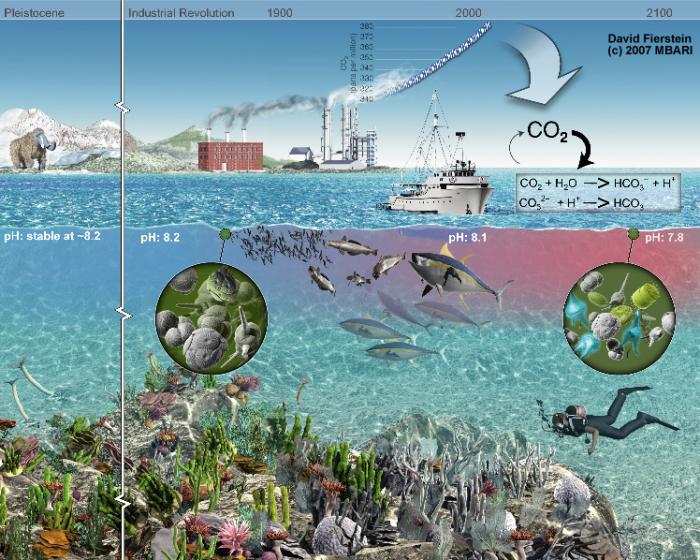Study finds increased ocean acidification due to human activities
More anthropogenic carbon in the northeast Pacific means weaker shells for many marine species
Oceanographers from MIT and Woods Hole Oceanographic Institution report that the northeast Pacific Ocean has absorbed an increasing amount of anthropogenic carbon dioxide over the last decade, at a rate that mirrors the increase of carbon dioxide emissions pumped into the atmosphere.
The scientists, led by graduate student Sophie Chu, in MIT's Department of Earth, Atmospheric, and Planetary Sciences, found that most of the anthropogenic carbon (carbon arising from human activity) in the northeast Pacific has lingered in the upper layers, changing the chemistry of the ocean as a result. In the past 10 years, the region's average pH has dropped by 0.002 pH units per year, leading to more acidic waters. The increased uptake in carbon dioxide has also decreased the availability of aragonite -- an essential mineral for many marine species' shells.
Overall, the researchers found that the northeast Pacific has a similar capacity to store carbon, compared to the rest of the Pacific. However, this carbon capacity is significantly lower than at similar latitudes in the Atlantic.
"The ocean has been the only true sink for anthropogenic emissions since the industrial revolution," Chu says. "Right now, it stores about 1/4 to 1/3 of the anthropogenic emissions from the atmosphere. We're expecting at some point the storage will slow down. When it does, more carbon dioxide will stay in the atmosphere, which means more warming. So it's really important that we continue to monitor this."
Chu and her colleagues have published their results in the Journal of Geophysical Research: Oceans.
The Oxaca Commune And The Zapitastas: Hope From The Margins
In the south of Mexico people are regenerating the society from the bottom up. It is a new kind of revolution without leaders, which goes beyond development and globalization. It is about displacing the economy from the center of social life, reclaiming a communal way of being, encouraging radical pluralism, and advancing towards real democracy.
http://www.countercurrents.
Science or Snake Oil: is A2 milk better for you than regular cow’s milk?
For those who do not experience any problems with milk consumption, there is no evidence to suggest any benefit in having A2 milk over the common consumed commercial milk, which contains both the A1 and A2 proteins. For less than half the price per litre, the latter would be the favoured option.
US Plans to ‘Corner’ Russia on Syria’s Chemical Weapons
The Obama administration is pushing UN reports showing Assad hasn’t given up, and is in some cases still using, poison gas. The strategy is to pressure the dictator’s patron, Vladimir Putin.

